Preservation Mindset, Part Two
Dipping into sustainability, a conversation with Emily De Sousa and Swordfish Piccata
Sustainability is a dynamic topic, to say the least. Considerations for how we preserve marine populations for the future are impacted by a wide range of influences. As new perspectives, innovations and research get added to the mix, conversations around seafood sustainability evolve on a regular basis. There’s a lot to keep up with.
I am extra sympathetic to home cooks who aren’t spending a large chunk of their days reading about seafood, who may feel unsure about what the most sustainable choices are at the store. I do spend a lot of time engrossed in seafood and I’m still not always sure myself.
I’ll do what I can, starting this issue, to help make those shopping decisions a bit easier. Every time we make a point of choosing the more sustainable options, we reinforce the value that sustainability holds for seafood consumers, ensuring continued diligence of sustainable practices well into the future.
On tap for next newsletter, the focus turns to cookbooks, including Eric Ripert’s new Seafood Simple, along with reflections on the first seafood cookbook I had a role in (very tiny, though it was; my role, not the book) and other musings on seafood in book form. Do you have a favorite cookbook or two you turn to again and again for seafood cooking inspiration? I’d love to hear about them in the comments below.

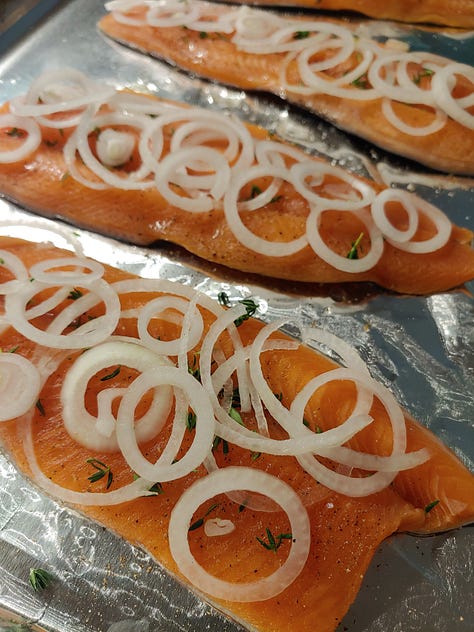
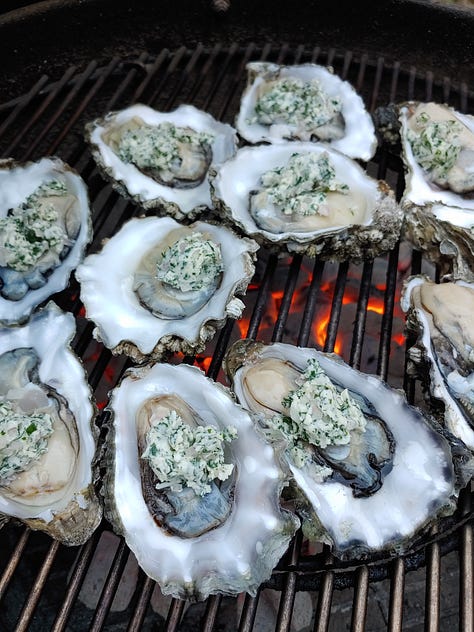
Seafood Conversations: Emily De Sousa
This is the first of brief chats with people in the world of seafood that I’ll be including in the newsletter now and then. It's such a pleasure to start things off with Emily De Sousa (with apologies to her, we talked a few months ago, I’m way behind).
These are intended to be relaxed, quick introductions to people in the business who I appreciate learning from and spending time with. As was true of this conversation I had with Emily, it’s very easy to get caught up talking about 101 interesting and delicious things—a few highlights from which I’ll share with you here. Other tidbits may make their way into future newsletters.
A quick intro: Emily’s work blends her foundation in fisheries science with her love of travel and pretty much all things seafood. She devotes a lot of time to communicating about seafood through her newsletter, social media, speaking engagements, consulting work and other projects. You’ll find her on Instagram at seasidewithemily (same handle on TikTok) and at her website Seaside with Emily where you can sign up for her weekly newsletter.
Home base: The Toronto area has been home for Emily her whole life, and she has family roots in the Azores Islands off the coast of Portugal.
How we met: At a conference put on by Local Catch in Alaska in the fall of 2022. Emily had crossed my radar the previous year, as I searched around the web and social media to catch up on what I’d been missing in the world of seafood beyond shellfish.
A quote of note: About her work as a translator of sorts between the seafood industry and consumers, “[Consumers] can’t love what they don’t understand.”
When I asked Emily to describe the work she’s doing, she said “I see my role as an educator, making connections between the average consumer and the seafood industry, which hasn’t always been transparent or easy to understand. I want to help get people to love seafood, for its nutrition, sustainability, versatility. There are still barriers to making seafood more approachable.”
As for where the motivation for her career path came from, Emily has particular clarity. “I joke that my entire career in seafood is built on my ability to hold a grudge.” Her undergrad studies were in environmental governance and she’d always been interested in the ocean, which included getting SCUBA certified and volunteering with marine-based organizations. “Seafood actually wasn’t the top of my mind, it was the ocean in general.” When she began to hear—while an undergrad student—some people express things like ‘there’s no such thing as sustainable fishing’ and ‘if you really love the oceans you can’t eat seafood,’ she was alarmed. She thought about the islands where her family is from, the fishermen there who take such great care to protect their resources. “I was really hell-bent that it could not be true but of course all I had was a feeling. So I said, you know what? I’m going to go to grad school, I’m going to learn the science of this. I know in my heart that this is wrong but I want the actual facts and data to back it up so I can prove that you can eat seafood sustainably.”
Regarding where she finds the most seafood-related inspiration, Emily notes how fortunate she is in getting to travel a lot. “Travel has always been a passion of mine, that’s where I draw a lot of my inspiration from. Seeing things first-hand has fueled a lot of my desire to go further into seafood, seeing how different seafood is around the world and how people approach it, both from a sustainability perspective and a culinary perspective. … Going hand in hand with traveling is just meeting people and hearing their seafood stories. Every time I meet with fishermen or farmers or chefs I learn something new about seafood.”
We covered a lot of other territory on our call, including her memories of seafood at family holiday gatherings, how much she loves eating seafood in Spain, and problem-solving innovations she’s optimistic about in the industry. Keeping up with Emily (or at least trying to!) will provide you some vicarious travel, a bit of wanderlust perhaps and a wide range of insights about the seafood industry that can help you navigate your seafood experiences a bit more confidently.
So, about sustainable seafood…
There’s no single, universally-agreed-upon definition that I know of. Though at the core is an understanding that maintaining healthy populations of seafood for generations to come is paramount. Some of its other facets relate to other species impacted by a fishery, health of the ecosystem where the seafood lives and the well-being of the people who harvest, process or otherwise work to get the seafood to us.
The Monterey Bay Aquarium’s Seafood Watch program is known for their green (“best choice”), yellow (“good alternative”) and red (“avoid”) coded ratings on which many rely for judging the sustainability of a particular seafood—available on their website and app. This page on the website focuses on their perspectives about and approach to sustainable seafood. You’ll also find plenty of other links from there to pages about different facets of sustainability in the seafood industry, including tips for consumers.
You’re likely familiar with the blue fish logo of the Marine Stewardship Council, which can be found on seafoods they have certified as being sustainable. Among other certifications you may see on packaging or signage include BAP (Best Aquaculture Practices) and ASC (Aquaculture Stewardship Council). Some stores may include reference to Seafood Watch ratings for specific items, or somehow let customers know that they rely on those ratings when sourcing what they sell.
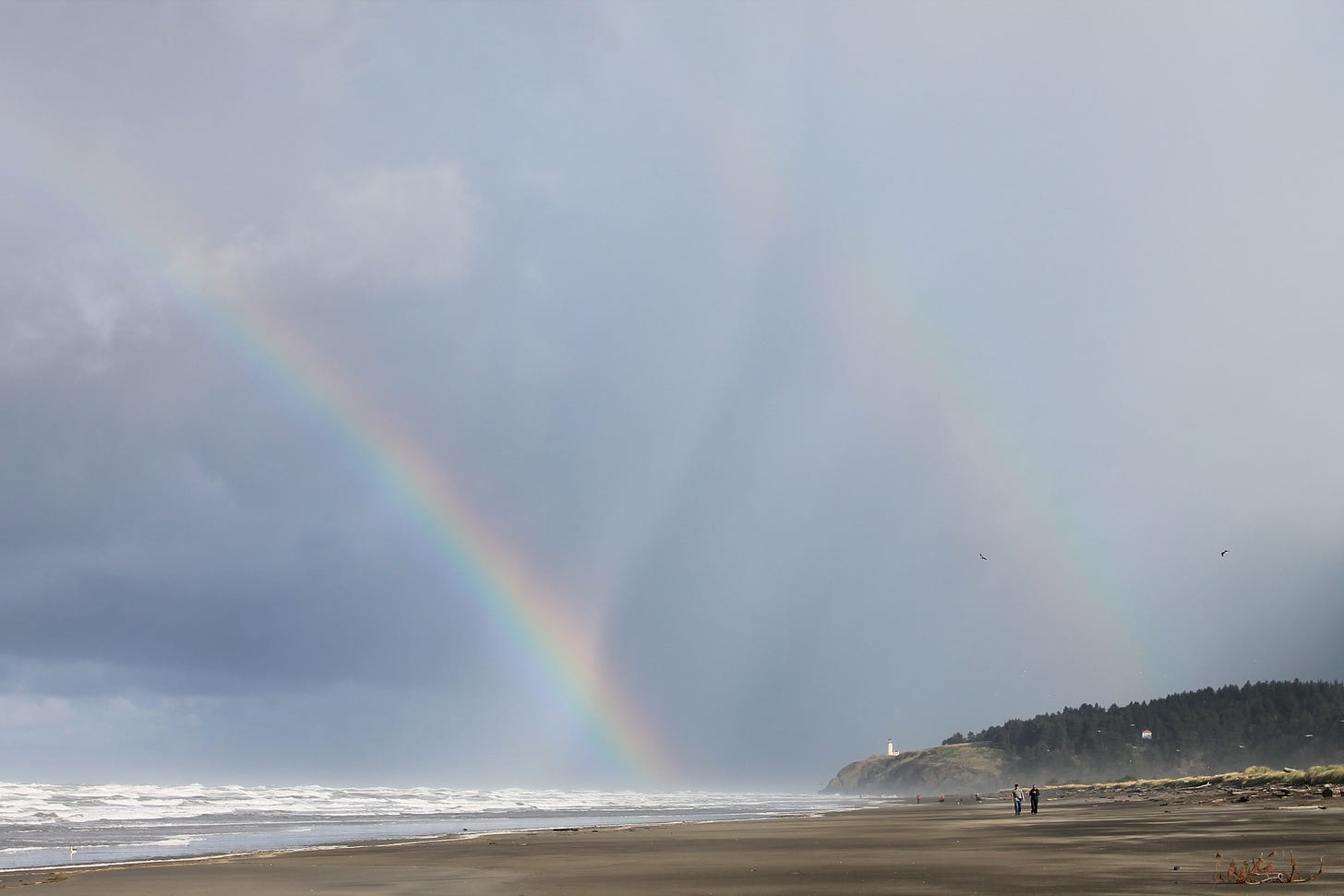
We each approach seafood selections with a range of potentially different factors in mind and our individual values coming into play. For some seafood shoppers, local may win out over seafood from another part of the country, or the world, because distance traveled and the related carbon footprint are of great importance. Others may prefer to seek out smaller, regional sources based on their values of supporting independent businesses versus larger operations. Some, of course, may not put a whole lot of advance thought into it, sustainability perhaps just one of a few (or more) considerations when they’re choosing what to cook for dinner.
As for some initial tips, I wish I could say there was one simple thing to do if your goal is to buy the most sustainable seafood you can. The closest version of that is to shop at stores (or online and other options) that make their sustainability values clear, where you can feel confident in both the quality of the seafood itself and that what they’re selling has been sourced responsibly, thoughtfully.
Otherwise, a few general suggestions, things I keep in mind myself when I’m shopping:
Do a bit of research about the seafoods you enjoy the most so you have an idea of the best choices before you shop. It’s good to revisit things now and then; if you’re relying on what you knew to be true a few or more years ago, there may have been some change. Seafood Watch is a good starting point, though it can take some work to wade through the degree of detail (various species, regions, harvest methods) to find ratings for the specific seafood item you might be considering. They do have “buying guide” overviews for some types of seafood with summarized guidelines.
Look for signage in the seafood case or on packages for any sustainability-related details about the items; as noted above they might include the MSC, ASC or BAP certification logos, among other third-party certifications. Or the store may state, broadly, their approach to responsible sourcing or sustainability guidelines they follow.
And don’t hesitate to ask questions of the staff to clarify anything you’re curious about, engage in conversation with the folks behind the counter. That’s double-valuable, because you’ll learn things about the seafood (hopefully; stores with well-informed, helpful staff are worth seeking out), and they’ll learn more about what their customers care about.
Swordfish Piccata
I’m not a piccata expert by any stretch, in fact capers were on my “thanks, but no thanks” list for a large chunk of my life. It was a dinner of chicken piccata that a friend made a decade or so years ago that turned me around and I’ve since invited capers into my repertoire more and more. A quick survey of various approaches to piccata—using veal, chicken, turkey and sole among them—finds recipes that might include minced shallot, white wine, dried pepper flakes and/or chopped parsley. All great flavor additions that I’ve used now and then as well. For this recipe, I’m keeping it extra simple, focused on the delicious fish accented by lemon juice, capers and butter.

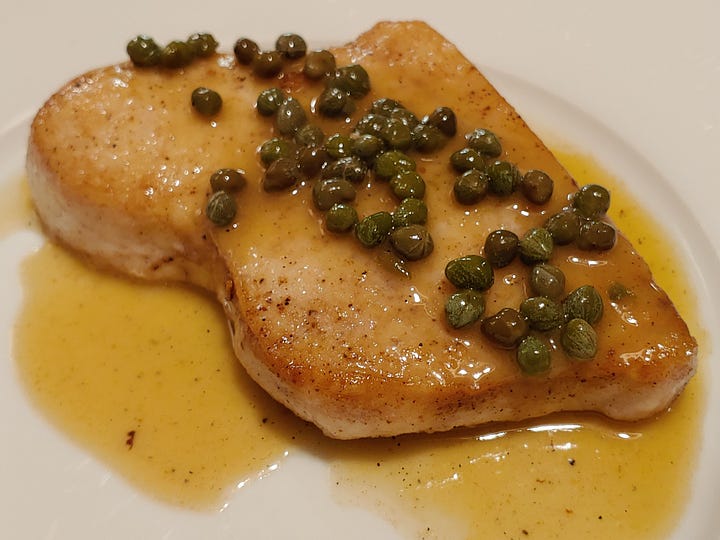
For any other pan-frying of meaty swordfish, I wouldn’t consider coating it in flour first—the fish’s density and richness help a nicely browned surface form as is. In the spirit of traditional piccata preparations, I did coat them for this recipe and found I really liked the bit of toasty character the browned coating provided. Feel free to skip that step if you like.
2 swordfish steaks, about 7-8 ounces each (about 1 inch thick)
Kosher salt and freshly ground black pepper
2 to 3 tablespoons all-purpose flour
1 tablespoon olive oil
2 tablespoons unsalted butter, divided
3 tablespoons freshly squeezed lemon juice
2 tablespoons nonpareil capers, drained
Season the swordfish steaks lightly on both sides with salt and pepper. Dredge both sides of the steaks with flour, patting to remove excess.
Heat the olive oil with 1 tablespoon of the butter in a large heavy-bottomed skillet over medium-high heat, putting the rest of the butter in the fridge to chill until needed. Swirl the pan gently to mix the oil and butter as it heats. When the butter is melted, add the swordfish steaks and cook until nicely browned, 3 to 4 minutes. Turn the steaks and cook until browned and just a touch of translucence at the center, about 3 minutes longer. Adjust timing as needed if your steaks are much thinner or thicker than about 1 inch.
Transfer the swordfish to individual warmed plates and reduce the heat to medium. Carefully add the lemon juice and capers to the skillet, whisking to mix. Add the chilled butter and gently whisk until it has melted creamily into the sauce. Spoon the capers and sauce over the swordfish steaks and serve right away.
Makes 2 servings





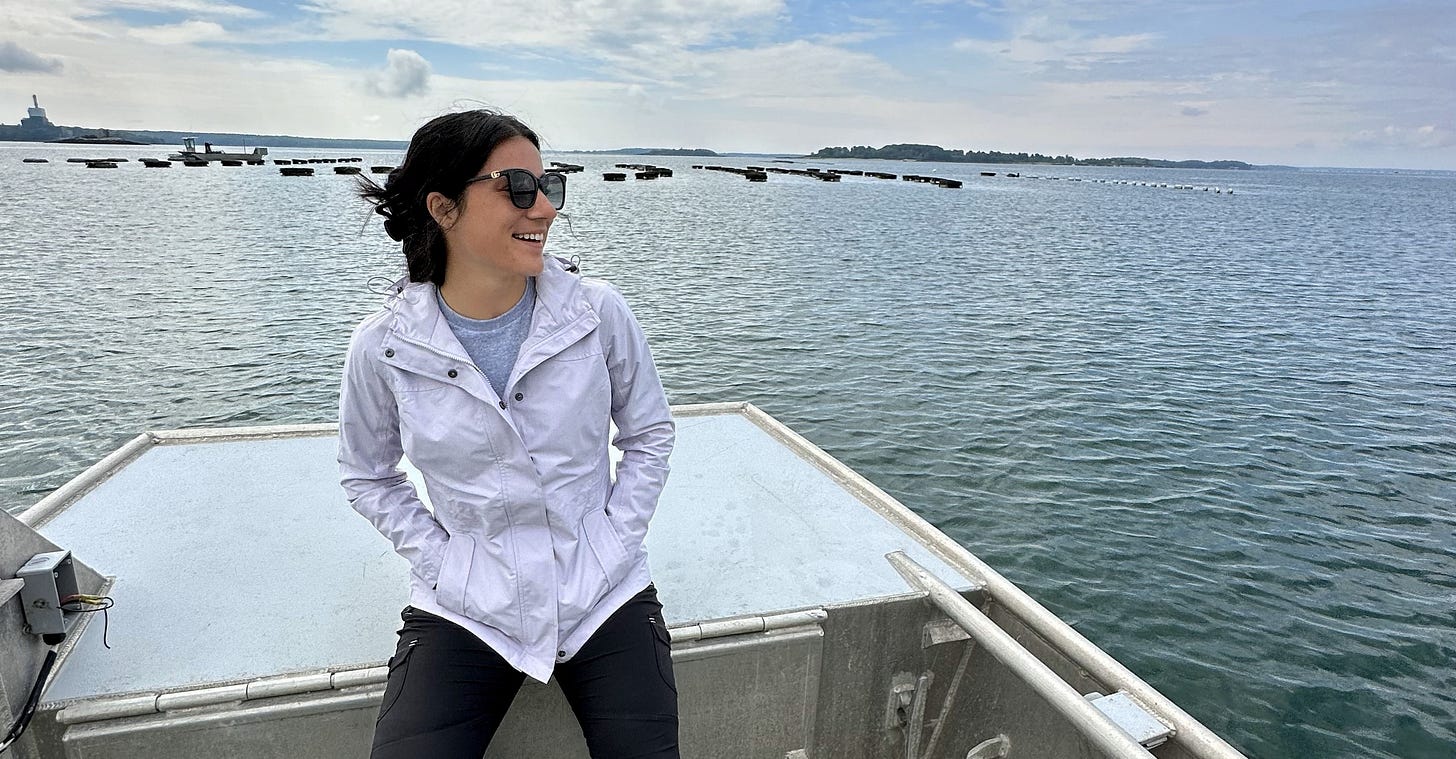
I learn several things each time I read your stories. Smiling and grateful. Thank you!